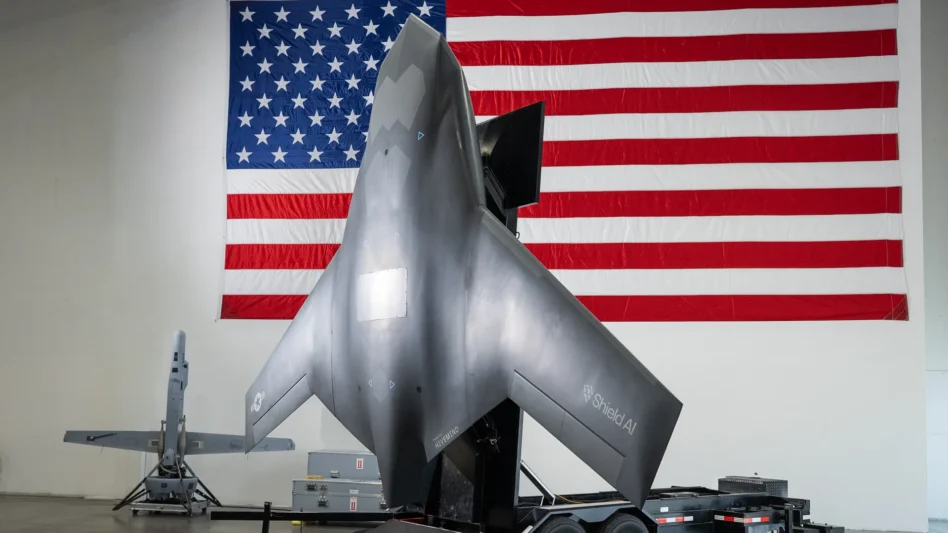Looks like Shield AI is getting serious about the whole CCA thing. Yesterday, the company announced that it’s teaming up with jet engine megalith GE Aerospace ($GE) to power its newly announced little drone fighter, X-BAT.
The two companies signed a Memorandum of Understanding stating that “the F110-GE-129 engine, featuring the advanced Axisymmetric Vectoring Exhaust Nozzle (AVEN), has been selected to power the X-BAT,” according to a statement put out by both companies.
GE will also “provide propulsion and testing support for the X-BAT program.” Well, if you’re trying to go fast—and build fast—it seems like a pretty good idea to team up with one of the OGs.
Fast friends: In case you missed the buzzy launch ceremony, Shield AI unveiled a CCA concept called X-BAT in DC on October 21. The autonomous fighter, the company said, will be long-range, jet-powered, and capable of carrying some big ol’ payloads.
- X-BAT is about 26 feet long and has a 39-foot wingspan—big for a CCA—but the company says it offers the same capabilities as a manned fighter in a smaller package.
- It’s also, well, not cheap—CNBC reported that the drones will come in at about $27M a pop.
- At the launch, Shield AI SVP of aircraft Armor Harris said that the drone’s jet engine would give it a 2,000 nautical mile range and a service ceiling of 50,000 feet. For what it’s worth, an F-15’s service ceiling is about 60,000 feet.
- The X-BAT concept also has multiple weapons bays and space for ISR payloads.
- The whole thing will run on Shield AI’s Hivemind software—the autonomy brain. At launch, the Shield team said that X-BAT would be able to both act as part of a swarm in connected environments and “hunt on its own” when comms are jammed.
Basically, the idea is that the X-BAT can do everything that something like an F-15 can do, but without a pilot and in a smaller form-factor, and for a whole lot less cash.
Legacy: In case you haven’t picked up on it yet, Shield AI is following through on one of the biggest promises it made at the X-BAT unveiling—that the autonomous fighter would be powered by the same engine that powers the F-15.
- The F110-GE-129 engine famously powers both the F-15 and the F-16 and has been flown since the late 1980s. That’s practically ancient around here.
- It’s the workhorse of modern fighter engines—it can provide up to 30,000 pounds of thrust, which for something like X-BAT will mean serious acceleration, speed, and maneuverability.
- The engine is also digitally controlled with FADEC (Full Authority Digital Engine Control), which means a computer constantly tweaks fuel flow and airflow.
- It’s also designed to be modular, easy to upgrade and maintain, and can pop into a whole range of aircraft.
- The Axisymmetric Vectoring Exhaust Nozzle (AVEN) will provide “thrust vectoring capability for vertical flight and enhances maneuverability in horizontal flight,” according to the statement.
It’s also, well, PFB (pretty fucking big)—the engine is about the size of a small car, and weighs about 3,800 pounds. That explains the whole not-so-tiny tiny plane thing.
Built different: It’s worth noting that this engine puts Shield’s X-BAT in a totally different class than CCAs like Anduril’s YFQ‑44A and GA’s YFQ-42A.
- Anduril’s variant flies a Williams International FJ44-4 engine with about 3,600 pounds of thrust, according to Breaking Defense.
- GE and Kratos have actually teamed up to produce smaller engines for the more “mass producible” flavor of CCA. Honeywell and Pratt & Whitney are also working on similar models.
BFFs: Shield and GE say this new partnership will help speed up the development of “future unmanned applications.” Good thing too, because Shield says it plans to test the plane next year and carry out full mission capability testing in 2028.
It’s not clear yet what program Shield is gunning for (Anduril and GA have been tapped by the Air Force, and Anduril, Northrop Grumman, Boeing, and General Atomics are developing concepts for the Navy), but it’s worth noting that X-BAT is one of more than a few more advanced CCA concepts to be unveiled in recent months.
- Lockheed Martin unveiled Vectis, its CCA concept, in September.
- Northrop Grumman has been working on a CCA-like drone called “Project Lotus.”
What’s that? Do we smell another shiny new advanced CCA program cooking?

